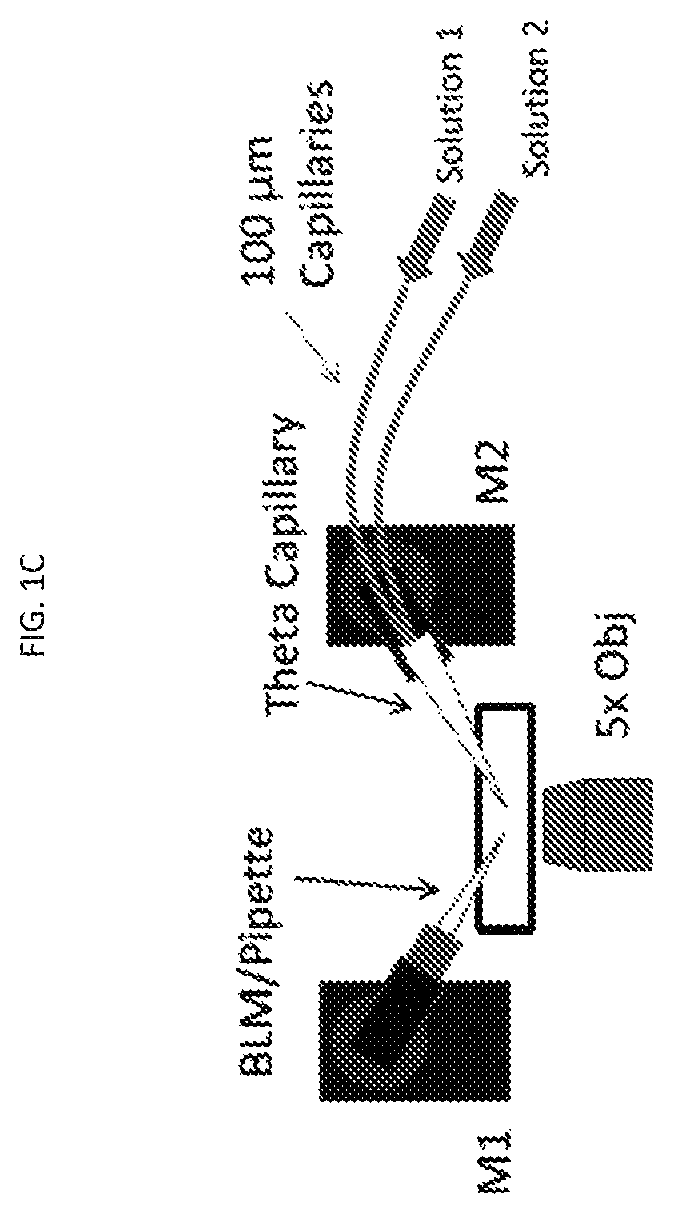Rapid conductance based ion channel analysis
a conductance-based ion channel and conductance-based technology, applied in the field of rapid conductance-based ion channel analysis, can solve the problem that relatively little work has addressed analytical performance criteria, and achieve the effects of rapid temporal response, reduced collection time, and high sensitivity
- Summary
- Abstract
- Description
- Claims
- Application Information
AI Technical Summary
Benefits of technology
Problems solved by technology
Method used
Image
Examples
example 1
[0103]The following is a non-limiting example of conductance-based measurements of gated-IC activity performed with enhanced temporal resolution. Equivalents or substitutes are within the scope of the invention.
Experimental
[0104]Chemicals and Materials:
[0105]KCl, CaCl2, 2-[4-(2-hydroxyethyl)piperazin-1-yl]ethane sulfonic acid (HEPES), and Gramicidin A (gA) were purchased from Sigma Aldrich (St. Louis, Mo.). 3-(Cyanopropyl)-dimethylchlorosilane was purchased from TCI America (Portland, Oreg.). 1,2-Diphytanoyl-sn-glycero-3-phosphocholine (DPhPC) was purchased from Avanti Polar Lipids (Alabaster, Ala.). HNO3 was purchased from Mallinckrodt (St Louis, Mo.). Ethanol (EtOH) was purchased from Decon Labs (King of Prussia, Pa.) and acetonitrile (ACN) was purchased from EMD Millipore (Darmstadt, Germany). All compounds were used as received.
[0106]Pipette fabrication and modification of large aperture pipettes: 1.5 mm (o.d.)×1.0 mm (i.d.) borosilicate capillaries (World Precision Instruments,...
example 2
[0155]The following is a non-limiting example of a sub-millisecond conductance protocol for ion channel measurements. Equivalents or substitutes are within the scope of the invention.
[0156]Improvements to the glass microaperture platform to realize, low-noise recordings with sub-millisecond response times up to 10 kHz bandwidth are described herein. A modified version of the conductance protocol developed in Example 1 is described which realizes 0.9 ms temporal resolution. Additionally, the capability of the optimized sub-ms conductance protocol to track, with high-fidelity, μs changes in ion concentration is demonstrated. The response time of this ion channel-functionalized biosensor is expected to be suitable for studying single cell exocytosis.
Experimental
[0157]The 3 μm glass microapertures were fabricated and the BLMs were formed by the tip dip method as previously described.
[0158]Electrophysiology and Noise Measurements:
[0159]Electrophysiological data was acquired with a HEKA E...
PUM
| Property | Measurement | Unit |
|---|---|---|
| diameter | aaaaa | aaaaa |
| voltage | aaaaa | aaaaa |
| length | aaaaa | aaaaa |
Abstract
Description
Claims
Application Information
 Login to View More
Login to View More - R&D
- Intellectual Property
- Life Sciences
- Materials
- Tech Scout
- Unparalleled Data Quality
- Higher Quality Content
- 60% Fewer Hallucinations
Browse by: Latest US Patents, China's latest patents, Technical Efficacy Thesaurus, Application Domain, Technology Topic, Popular Technical Reports.
© 2025 PatSnap. All rights reserved.Legal|Privacy policy|Modern Slavery Act Transparency Statement|Sitemap|About US| Contact US: help@patsnap.com



